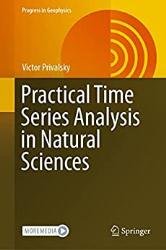 Название: Practical Time Series Analysis in Natural Sciences
Название: Practical Time Series Analysis in Natural SciencesАвтор: Victor Privalsky
Издательство: Springer
Год: 2023
Страниц: 209
Язык: английский
Формат: pdf (true), epub
Размер: 20.08 MB
This book presents an easy-to-use tool for time series analysis and allows the user to concentrate upon studying time series properties rather than upon how to calculate the necessary estimates. The two attached programs provide, in one run of the program, a time and frequency domain description of scalar or multivariate time series approximated with a sequence of autoregressive models of increasing orders. The optimal orders are chosen by five order selection criteria. The results for scalar time series include time domain stochastic difference equations, spectral density estimates, predictability properties, and a forecast of scalar time series based upon the Kolmogorov-Wiener theory. For the bivariate and trivariate time series, the results contain a time domain description with multivariate stochastic difference equations, statistical predictability criterion, and information for calculating feedback and Granger causality properties in the bivariate case. The frequency domain information includes spectral densities, ordinary, multiple, and partial coherence functions, ordinary and multiple coherent spectra, gain, phase, and time lag factors. The programs seem to be unique and using them does not require professional knowledge of theory of random processes. The book contains many examples including three from engineering.
The goal of this book is to provide researchers and students who do not have a serious knowledge of theory of random processes and respective methods of analysis with a proper tool that allows one to easily obtain statistical information which is necessary for studying natural processes and which are still almost unknown in natural sciences.
We live in a world where all processes generated by nature are random. It means that the behavior of any natural process presents a random (or stochastic) process and that its behavior is controlled by probabilistic laws. In order to study these processes, understand them, and learn how to predict them, we need to apply methods of analysis developed within the framework of theory of random processes. The current mathematical apparatus offers efficient methods for studying time series—the sample records of random processes—in both time and frequency domains, for building their stochastic models, which reveal statistical properties of sample records, for classifying them as belonging to different types of random processes and, in particularly, for time series predictions.
The only non-random, or deterministic process that we know on Earth is tides, which are generated by the lunar and solar gravity forces. Theoretically, they can be forecasted without an error at any lead time. The methods developed within the theory of random processes are intended for working with sample records of scalar and multivariate random processes, that is, for analysis of scalar and multivariate time series. The methods can be quite complicated and learning them may be a problem for nature researches. The book and its attachments are supposed to greatly simplify the computational part of time series analysis and, what is especially important, to put it upon the proper mathematical basis.
Each time series (also called a random function of time) presents a time-dependent sequence of random variables; its analysis includes some obligatory tasks which the researcher has to solve irrespective of his or her final goal. If the time series is scalar (a single record), such tasks include:
• determining the degree of proximity of its probability distribution function to the Gaussian (normal) curve; a Gaussian time series has some important properties not possessed by other processes;
• getting a sample correlation function estimate and its autoregressive extension;
• describing the time domain behavior of the time series explicitly with a stochastic difference equation;
• estimating the spectral density of the time series; if you do not know the time series spectrum, you know practically nothing about the time series;
• analyzing the time series statistical predictability and forecasting it in agreement with the theory of random processes.
Building a time domain model of the time series in the form of equation is important because it gives you an explicit picture of its internal structure within the time domain. It is also necessary if you intend to predict the time series, that is, to determine its probable trajectory and the variance of the forecast error as functions of lead time. The scalar time series are analyzed and forecasted here with the executable program AVESTA1.
If your time series is multivariate (consists of more than one scalar time series), the number of compulsory tasks increases. The time series analyzed with the executable program AVESTA3 attached to the book is treated as a sample of a linear stochastic system having one output time series and one or two input processes. Aside from getting information about its probability distribution, correlation functions, and time domain models, you will get:
• quantitative estimates of relationships between the time series components; respective functions are frequency dependent because the relationship between time series varies with frequency (or with the time scale); this is true for all other characteristics in a multivariate case; the quantitative indicator of the dependence between time series is called the coherence function;
• the response of the output to each input (defined earlier with time domain models in the form of multivariate stochastic difference equations) described now with functions of frequency: spectral densities, coherence functions, coherent spectrum, frequency response functions (gain and phase factor) plus the previously unknown time lag factor.
All of these statistical characteristics are estimated and given to the user in a single printout. In the scalar case, it is done in one run of the program AVESTA1; the multi-variate time series are dealt within a single run of the program AVESTA3.
Скачать Practical Time Series Analysis in Natural Sciences